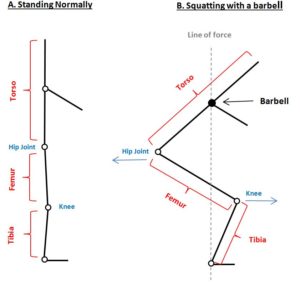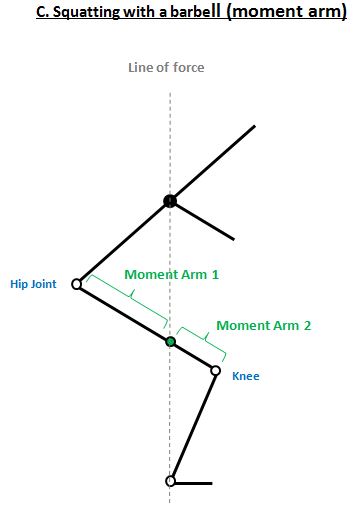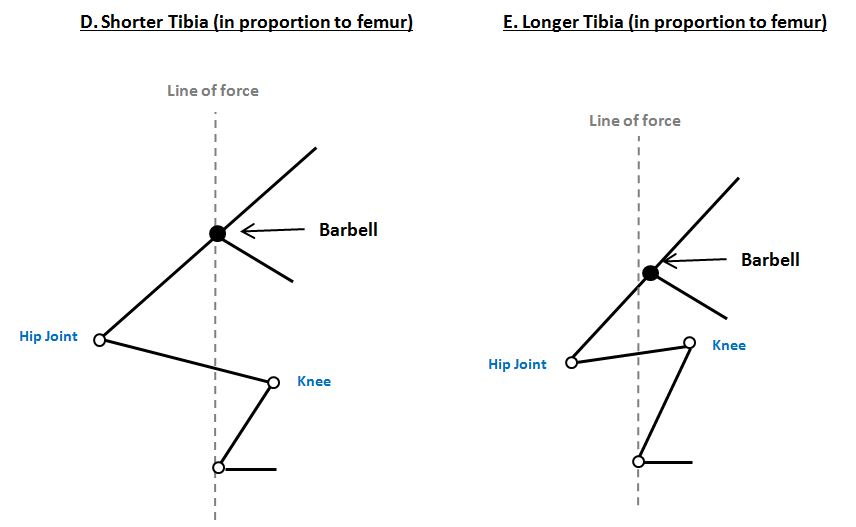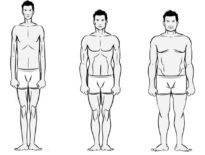Love them or hate them squats are one of the BEST exercises for putting on mass or losing weight. Every good workout routine includes some form of squats; there is simply no way around it. Since squatting is so important there is a plethora of information out there teaching you how to squat. A simple Google or YouTube search will show you countless videos of “experts” telling you how you must position yourself to squat properly.
The problem with a majority of this information is that it applies a “one method fits all” approach. Any site teaching you how to squat will convince you that their way is the best without explaining why nor taking into consideration your body proportions and flexibility level. These sites will say that you need to position your feet a certain width apart and squat down to a certain position otherwise you are not squatting correctly.
Whilst the underlying theory is correct, it’s only applicable for people that have the exact same body proportions as the person explaining how to squat. Not to mention that in videos about how to squat there is never any consideration given for tall people. I challenge you to find a good squat instructional video aimed for someone taller than 6 foot. If you do happen to find one, please let me know!
This does not mean tall people cannot squat. It means that as a tall lifter there are a few things you need to understand about your body first.
For a long time when I was squatting I was always conscious that my form looked different to other people at the gym. I tried copying the stances and barbell placements that shorter people were doing only to find that the squat movement felt wrong; sometimes bringing me close to the point of injury. Ultimately I went back to squatting in such a way “that felt right” which turns out, without realising it, I was squatting how I should based on my particular body proportions.
Basically: not all squats are created equal!
In this blog post I’m going to explain some fundamental principles of the squat and what effect your body proportions will have on your technique. By the end of this post I hope you’ll have a better understanding of how you can adjust your body to squat efficiently.
But first a little reminder about why squats are so great…
What’s So Great About Squats?
Squats are one of the most functional movements in our lives.
Ever since we were babies we’ve been squatting.
In some countries, predominantly third world, people sit around in full squat positions. In addition instead of sitting down on a toilet these people squat over it. Can you imagine hanging out with your friends with everyone squatting low to the ground? I know I can’t.
Squats are a compound movement; a simple body weight squat uses almost every muscle group in the body. Add a barbell onto your back (like in the cover photo for this article) and the squat will use every single major muscle group in your body to some degree. Because they utilise a large amount of muscle groups, studies have shown that squats cause your body to increase anabolic hormone production. This in turn helps us lose fat and gain muscle (along with a host of other things such as diet and lifestyle).
In short, squats are the king of exercises, offering you the best bang for your buck at the gym.
The Squat Bible
If you are a stickler for details and want the most comprehensive analysis of the squat I have ever seen then you must read Mark Rippetoe’s book, Starting Strength. What other book gives you a 67-page chapter dedicated to the squat!? In that book you will learn every single little thing you need to do to perform the perfect squat. It also provides numerous photos, diagrams and a step-by-step guide which, combined with the knowledge from this article, will transform you into a squat beast.
Basic Squat Mechanics
The best way to describe squat mechanics is to simplify our body into groups (upper and lower) and hinges.
The upper body is comprised of the torso and the lower body is comprised of the legs (further broken down into the femur and tibia). The upper and lower body are separated (and hinge on) the hips and the femur and tibia are separated (and hinge on) the knee. Figure A below shows these groups and hinges for a person standing normally.
When a barbell is loaded onto the back, the centre of mass falls over the feet creating what is known as a line of force (see Figure B). It’s along this line that everything will occur when a squat is carried out. During a squat the knee will go forward as the hips will go backwards. As soon as the knee goes forward (past the line of force) there is a moment generated; the same hold true for the hips. The moment arm generated is the weight of the barbell multiplied by the distance of the knee (or hip) from the line of force (see Figure C).
The further the knee goes forward the more the weight will influence your knee and knee muscles. Conversely if your knee goes forward only a small distance then your hips will take more of the load. I.e. If the distance from the line of force to the knee is halved then the load on the knee will be halved. For most people, the hips are usually better adapted to take a load than the knees. So ideally, it’s better to have a longer distance over the hips than it is over the knees. This leads me to my next point….
Not Everyone Squats The Same
The “correct” squat posture and position depends largely on your body proportions and length of your limbs. These proportions dictate which muscles you work more when you squat. Some people will feel squats mainly working theirs quads while others will feel it more in their lower back.
If your tibia is shorter in proportion to your femur (Figure D) then your body will dictate that you lean forward as your knees cannot go forward. This places more of the load on your lower back than it does on your quads. Conversely if your tibia is longer in proportion to your femur (Figure E) then you will “collapse” into a squat and you will feel more of the load on your knees and you will feel the squat working your quads. I fall into this second category and squatting often leaves me with very sore quads for the next few days.
Some people are unfortunate enough to have a much longer femur (in proportion to the tibia) but also a short torso (Figure F). This will make squatting feel like hell as your body proportions will dictate that you cannot sink low into the squat as you feel like you are going to fall. Instead you have to lean very far forward. Consequently you will feel the load almost entirely in your lower back and progressing to heavier weights will be challenging.
 It’s also worth mentioning that despite your body proportions there are two factors that add complexity to determining how far your knee can go forward.
It’s also worth mentioning that despite your body proportions there are two factors that add complexity to determining how far your knee can go forward.
- Dorsiflexion in the foot. This limits how far your tibia can go forward which completely influences how far back the hips have to go.
- Rise in your heel. The greater the rise in your heel, the further forward you can go.
In Summary
Body proportions are absolutely critical to how you position yourself to squat. The most important thing to remember is that there is no “one method fits all” approach. Everyone will have different body proportions and should never compare their squat technique with someone else. If you want to learn more about the squat and become a master then you absoulely cannot go past Mark Rippetoe’s book, Starting Strength.
I hope this information has been useful and will help you troubleshoot or better understand your squat.
If you have any questions of comments leave them below, I’d be interestred to hear your opinion.
Stand tall, be proud of your height and strive for greatness.
- Image credit for squat diagram (cover image): here





Nice job here. As a tall guy myself I’ve struggled with squats and learned through much trial and error what works best for me. Can’t go wrong with Starting Strength as a beginner for sure.
Thanks very much Jim. Keep up the good work following Starting Strength!